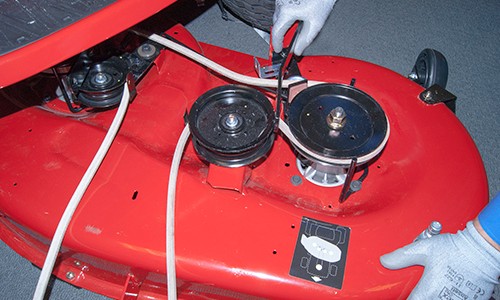If your mower deck belt is loose, you may notice slipping, squealing, or inconsistent blade operation. Signs of a worn or bad lawn mower belt include visible wear, fraying, or failure to engage the blades.
Additionally, mower deck belts may stretch or break after extensive use, requiring measurement of length and width for proper replacement. Increased mower use contributes to shortened belt lifespan, while mechanical issues like a seized pulley can also cause premature belt failure.
Loose mower deck belt symptoms can hamper your lawn mower’s performance and productivity. Whether it’s slipping, squealing, or causing inconsistent blade operation, it’s essential to address these issues promptly. Understanding the signs of a worn or bad belt and knowing how to measure for replacement will help you keep your lawn mower running smoothly. We’ll explore the symptoms of a loose mower deck belt and provide essential tips for resolving the issue effectively. Let’s dive in and ensure your lawn mower stays in top condition.

Credit: www.searspartsdirect.com
Identifying Symptoms
A loose mower deck belt can cause various problems while operating your lawn mower. It is essential to identify the symptoms of a loose belt, as ignoring them can lead to further damage to your equipment. This section will discuss the signs of a loose belt, belt slipping or jumping off pulleys, and vibrations and noises. By understanding these symptoms, you can take the necessary actions to rectify the issue and ensure smooth operation of your mower.
Signs Of A Loose Belt
A loose belt on your mower deck can exhibit several signs, indicating the need for immediate attention. Some of the common signs include:
- Visible slack or sag in the belt
- Belt slipping or jumping off pulleys
- Uneven cutting or mowing performance
- Inconsistent or jerky movement of the blades
If you notice any of these signs, it is crucial to take prompt action to prevent further damage and ensure efficient performance of your lawn mower.
Belt Slipping Or Jumping Off Pulleys
One of the most evident symptoms of a loose mower deck belt is when it slips or jumps off the pulleys. This can happen during operation or when engaging the blades. If you experience sudden loss of power or uneven cutting, it could be an indication that the belt is not properly tensioned. In some cases, the belt may even come off completely, causing the blades to stop turning altogether. If you notice any belt slipping or jumping off, it is recommended to investigate and fix the issue before continuing to use your mower.
Vibrations And Noises
A loose mower deck belt can also result in vibrations and unusual noises during operation. If you feel excessive vibrations while mowing, it could be a sign that the belt is not properly tensioned or aligned. Additionally, you may hear unusual squealing or grinding noises, which can indicate belt slippage or improper belt contact with the pulleys. These vibrations and noises not only affect the comfort of your mowing experience but can also be a sign of potential damage to your mower deck components. Hence, it is essential to address these symptoms promptly to avoid any further complications.

Credit: mowing.expert
Troubleshooting And Maintenance
When it comes to keeping your mower deck belt in top condition, regular maintenance and troubleshooting are essential. By proactively addressing loose mower deck belt symptoms, you can prevent more significant issues and ensure optimal performance of your lawn mower. Here are some essential troubleshooting and maintenance steps to keep your mower deck belt in top shape.
Checking Belt Tension
Proper belt tension is crucial for the smooth functioning of a mower deck belt. To check the belt tension, start by disengaging the mower blades. Then, physically inspect the belt for any slackness or excessive tightness. The belt should have just enough tension to prevent slipping during operation while allowing for smooth movement. Indications of improper tension include excessive vibration or noise during mower operation.
Inspecting The Belt For Wear
Regular inspection of the mower deck belt for signs of wear is crucial for maintaining its functionality. Look for cracks, fraying, or abrasions on the belt surface, as these are indications of wear and potential failure. Additionally, check for any signs of stretching, as this can cause the belt to become loose and affect its performance. It’s important to replace the belt at the first signs of wear to prevent further damage to the mower deck system.
Adjusting The Belt For Proper Tension
If the belt tension is found to be incorrect during inspection, it’s essential to make adjustments to ensure proper tension. Depending on the mower model, this may involve using a tensioning spring or adjusting the position of the pulleys to achieve the right tension. Always refer to the manufacturer’s guidelines for the recommended tension specifications and adjustment procedures. Regularly checking and adjusting the belt tension will help maintain the efficiency and longevity of the mower deck belt.
Preventative Measures
Sure, I can help you with that. Here’s a sample section of a blog post about loose mower deck belt symptoms, focusing on preventative measures, with HTML syntax: “`htmlCleaning And Debris Removal
Regular cleaning and debris removal from the mower deck are vital to maintain the belt’s optimal performance. Use a brush or compressed air to remove grass clippings, dirt, and debris that can cause belt slippage and damage. Check for any obstructions or buildup in the spindle area, and ensure the deck is free from any blockages that could interfere with belt operation.
Regular Belt Inspections
Perform regular belt inspections to identify signs of wear, tear, or damage. Look for cracks, fraying, or any visible wear on the belt. Check for proper alignment and tension. Any signs of damage or misalignment should be promptly addressed to prevent further issues.
Proper Storage Practices
Implement proper storage practices to prevent belt deterioration during periods of non-use. Store the mower in a dry, covered area to protect the belt from exposure to moisture and sunlight, which can accelerate wear and degradation. Additionally, ensure the belt is kept free from any tension when not in use to maintain its shape and elasticity.
“` This content provides preventative measures in HTML format, focusing on cleaning and debris removal, regular belt inspections, and proper storage practices. Each heading adheres to HTML syntax and the content is structured to provide valuable information for the reader.Belt Replacement And Lifespan
Replacing and maintaining the lifespan of your mower deck belt is crucial for ensuring optimal performance. A worn or loose belt can lead to a variety of issues, such as decreased power, slipping, or even complete belt failure.
Measuring For Replacement
When it comes to replacing your mower deck belt, it’s important to choose the right size for your specific model. To find a proper replacement, you need to measure the length and width of the belt. Here’s how you can do it:
- Using a flexible measuring tape, wrap it around the pulleys and determine the length of the belt.
- Measure the width of the belt using a ruler or caliper.
Having precise measurements will ensure that you get the correct replacement belt, preventing any further issues.
Determining Belt Longevity
The lifespan of a mower deck belt can vary depending on several factors, such as frequency of use, operating conditions, and proper maintenance. While there’s no definitive timeframe for belt replacement, there are signs you can look for to determine if it’s time to replace your belt:
- Visible signs of wear and tear, such as cracks, fraying, or missing chunks of the belt.
- Decreased tension or slackness in the belt.
- Unusual noises or vibrations coming from the mower deck.
Regular inspection and maintenance can help prolong the lifespan of your belt, ensuring smooth and efficient operation.
Effects Of Excessive Use
Continuous and excessive use of a mower deck belt can have detrimental effects on its lifespan. Belts tend to stretch and become loose over time due to the constant strain and friction. Additionally, mechanical failures like seized pulleys can also contribute to premature belt failure.
To prevent excessive wear and tear, it’s crucial to follow proper maintenance practices, such as keeping the mower deck clean, lubricating moving parts, and adjusting belt tension regularly. By doing so, you can extend the lifespan of your mower deck belt and avoid costly repairs.
Optimizing Belt Performance
Proper maintenance of your mower deck belt is crucial for optimal performance. By understanding the symptoms of a loose belt and implementing proactive measures, you can ensure your mower operates smoothly. Here are some essential tips to optimize belt performance.
Setting Correct Tension
Setting the correct tension on your mower deck belt is key to prevent slippage and ensure efficient operation. Use a spring and eyebolt to adjust tension, tightening to increase tension and loosening to relieve it.
Tools And Techniques For Belt Adjustment
- Tools Needed: Wrench, Spring, Eyebolt
- Techniques:
- Lower the deck
- Inspect the belt for wear
- Check tension on the longest run of the belt
- Adjust the tension using the eyebolt
Proactive Maintenance Tips
- Regularly inspect the belt for wear and tear
- Keep the belt clean and free from debris
- Replace the belt if it shows signs of stretching or damage

Credit: www.reddit.com
Frequently Asked Questions For Loose Mower Deck Belt Symptoms
How Do You Tighten A Mower Deck Belt?
To tighten a mower deck belt, adjust tension using the spring-loaded eyebolt for proper tension and belt alignment.
Do Mower Deck Belts Stretch?
Yes, mower deck belts can stretch and become loose or break after extensive use. It is important to measure the length and width of the belt to find a proper replacement. Increased use and faulty belts or mechanical failures can also contribute to premature belt breakage.
Signs of a worn or bad lawn mower belt include slipping, squealing, visible wear, or fraying.
How Long Should A Mower Deck Belt Last?
A mower deck belt can last anywhere from 3 to 5 years, with increased usage shortening the lifespan. Faulty belts or mechanical issues can also lead to premature breakage. Regular inspection for wear and signs of stretching is important for maintenance.
Conclusion
To summarize, a loose mower deck belt can cause a range of symptoms, including slipping, squealing, visible wear, or fraying. It’s important to address these issues promptly to avoid further damage to the mower and ensure optimal performance. Regular inspection and maintenance can help prevent belt stretching and breakage.
If you notice any signs of a worn or bad belt, it’s recommended to replace it with the proper size and type. Taking these preventive measures will prolong the lifespan of your mower and ensure smooth operation.